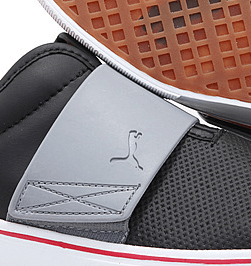Sneaker Design – 4 elements of great shoe design: S.L.A.M.
#1 Silhouettes
#2 Logos
#3 Accessories
#4 Materials

Silhouette [ sil-oo-et ]:
The outline or general shape of something:
Sneakers come in all shapes, from super sleek to ultra puffy, it is the designer’s choice.The silhouette of a sneaker is determined by the shoe last, the shape of the pattern parts, and the padding. Fashion trends, manufacturing techniques, and footwear technology are all at work. With your mind and eyes open, you can see classic shoes with iconic silhouettes and new shoes with dynamic unmistakable shapes.
Shoes built for the same function can have radically different silhouettes.
Let us take, for example, three running shoes produced by Nike in 1980, 1990, and 2020. Of course, we see vastly different manufacturing techniques and material combinations, yet we also see that all three have unique silhouettes. The shoe silhouette is delivered by the shoe last, outsole geometry, and most importantly, the pattern.



The shoe pattern is how you deliver the silhouette. What is the pattern? The pattern of a shoe is the shape of all the shoe’s individual upper parts. The shoe factory will use the pattern information to cut the parts and build the shoe.
A simple pattern makes a clean silhouette, a complicated pattern makes a wild silhouette.
Logos:
Design a logo strategy
The logo may be the most important part of your shoe. It may be the only reason a customer looks at your shoe design. Sometimes, the only reason a shoe exists is to carry the logo. If a new shoe design is uniquely radical or special in some way, the logo may just be along for the ride. In some cases, the logo may barely present itself, think of Yeezy or Prada.



Logos on shoes will have specific functions. The logo lets the customer know the brand that made the shoe and the athlete that endorses the shoe. Logos are used to communicate a technology, a special feature, or a partnership with another company, brand, or personality. The design of your logos may help you communicate a theme or principle, like sustainability, for example.
Every shoe design needs a logo design strategy. The design brief may give specific instructions, or the shoe brand may have a specific policy established as part of the overall corporate design strategy.
Accessories:
Transform your design into a shoe
The accessories of your design are key elements that make your shoe design into a real working shoe. The main accessory of your shoe design is the outsole componentry. The outsole of your shoe is usually the single most expensive part to design, develop and manufacture.
The outsole determines the price and performance of your shoe. The casual solid rubber cup sole unit may cost only $2.00, while the 4-part running sole with airbag may cost Nike $15.



Accessories can also be lacing systems, running computers, or injection molded upper components. Anything that delivers your technology or the theme of your shoe design.
Materials:
What is your shoe made of?
The material selections for your sneaker design will determine the construction, price, performance, weight, and import duty. There are thousands, if not millions, of material options for a shoe designer. Your shoes’ functional requirements and design theme will help you make your selections. The performance requirements and price targets of your shoe design will help you narrow the selection.



Some important points to detail in specifying materials are the color, texture, thickness, backing type, backing color, price, and MOQ. (Minimum Order Quantity). We have written an entire book on the subject of footwear materials.
See the Shoe Material Design Guide

